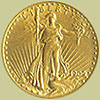Honest Money
Gold & Silver Report
Gold Wars: Intervention &
Manipulation
Douglas V. Gnazzo
Honest Money Gold & Silver Report 3/26/06 - snippet
Posted March 28, 2006
 For Zorro
"Nor shall he
meanwhile suffer any evil or harm,
For Zorro
"Nor shall he
meanwhile suffer any evil or harm,
until he sets foot upon his own land; but thereafter he shall
suffer whatever
Fate and the dread Spinners spun with their thread for him at
his birth, when his mother bore him." [1]
Abstract
For those who say that market
intervention and manipulation does not occur, they are either
deaf, dumb, blind, or all three: the proverbial monkey who hears
no evil, sees no evil, and speaks no evil oh how I wish
it were so. Perhaps one day soon it will be. Until then we remain
undaunted, ever vigilante, at our post.
Questions often asked: who
would intervene in the market? Why would they intervene in the
market? How could they intervene in the market? Even if they
did intervene would what they do actually manipulate the market?
How could this go undetected?
Is there any precedent of market
intervention and manipulation in the past that would exhibit
that such a pattern of behavior has previously occurred and is
therefore reasonably probable or at the least possible?
Precedents
We will site ten (10) examples,
as that is the number of appendages by which we grasp, whatever
it is that we seek.
Daniel Drew
 "In 1857, Drew
became a member of the board of directors of the Erie Railroad
and used his position to manipulate the firm's stock price. "In 1857, Drew
became a member of the board of directors of the Erie Railroad
and used his position to manipulate the firm's stock price.
"In 1864, Drew once again
struggled with Vanderbilt, speculating on the stock of the Harlem
Railroad. Drew was selling the stock short, but Vanderbilt and
his associates bought every share he sold, ultimately causing
the stock price to rise from 90 to 285 in five months. Drew lost
$500,000.
In 1866-1868, Drew engaged
in the Erie War, in which Drew conspired along with James Fisk
(financier) and Jay Gould to issue fraudulent stock to keep Vanderbilt
from gaining control of the Erie
Railroad. Vanderbilt sustained heavy losses and conceded control
of the railroad to the trio. In 1870, Fisk and Gould betrayed
Drew, manipulating the stock price of the Erie Railroad and causing
him to lose $1.5 million. The Panic of 1873 cost him still more,
and by 1876, Drew filed for bankruptcy, with debts exceeding
a million dollars and no viable assets. He died in 1879, dependent
on his son for support." [2]
James Fisk
 "In 1864 he became
a stockbroker in New York and was employed by Daniel Drew as
a buyer. He aided Drew in his war against Cornelius Vanderbilt
for control of the Erie Railroad, which resulted in Fisk and
Jay Gould becoming members of the Erie directorate. Subsequently,
a well-planned raid netted Fisk and Gould control of the railroad. "In 1864 he became
a stockbroker in New York and was employed by Daniel Drew as
a buyer. He aided Drew in his war against Cornelius Vanderbilt
for control of the Erie Railroad, which resulted in Fisk and
Jay Gould becoming members of the Erie directorate. Subsequently,
a well-planned raid netted Fisk and Gould control of the railroad.
The association with Gould
continued until his death. They carried financial buccaneering
to extremes, their program including open alliance with Boss
Tweed, the wholesale bribery of legislatures, and the buying
of judges.
Their attempt to corner the
gold market culminated in the fateful Black Friday of September
24, 1869.
It was during the same period
that Gould and James Fisk became involved with Tammany Hall;
they made Boss Tweed a director of the Erie, and Tweed, in turn,
arranged favorable legislation for them. Tweed and Gould became
the subjects of political cartoons by Thomas Nast in 1869. In
October 1871, when Tweed was held on $1 million bail, Gould was
the chief bondsman." [3]
Black Friday
 "In August
1869, Gould and Fisk began to buy gold in an attempt to corner
the market, hoping that the increase in price of gold would increase
the price of wheat such that western farmers would sell, causing
a great amount of shipping of breadstuffs eastward, increasing
freight business for the Erie railroad. "In August
1869, Gould and Fisk began to buy gold in an attempt to corner
the market, hoping that the increase in price of gold would increase
the price of wheat such that western farmers would sell, causing
a great amount of shipping of breadstuffs eastward, increasing
freight business for the Erie railroad.
During this time, Gould used
contacts with President Ulysses S. Grant's brother-in-law, A.H.
Corbin, to try to influence the president and his Secretary General
Horace Porter.
These speculations in gold
culminated in the panic of Black Friday, on September 24, 1869,
when the premium over face value on a gold Double Eagle fell
from 62% to 35%. Gould made a nominal profit from this operation,
but lost it in the subsequent lawsuits. The affair also cost
him his reputation." [4] ...
... Read the full
report on Doug's new website.
References
[1] Alcinous
on Odysseus. Homer, Odyssey 7.195
[2] Wikipedia
[3] Wikipedia
[4] Wikipedia
-Douglas V. Gnazzo
email: Douglas V, Gnazzo
Douglas
V. Gnazzo
is CEO of New England Renovation LLC, a historical restoration contractor
that specializes in restoring older buildings that are vintage historic
landmarks. He writes for numerous websites and his work appears
both here and abroad. Just recently he was honored by being
chosen as a Foundation Scholar for the Foundation for
the Advancement of Monetary Education (FAME).
©2006
Douglas V. Gnazzo. All
Rights Reserved.
321gold Inc

|